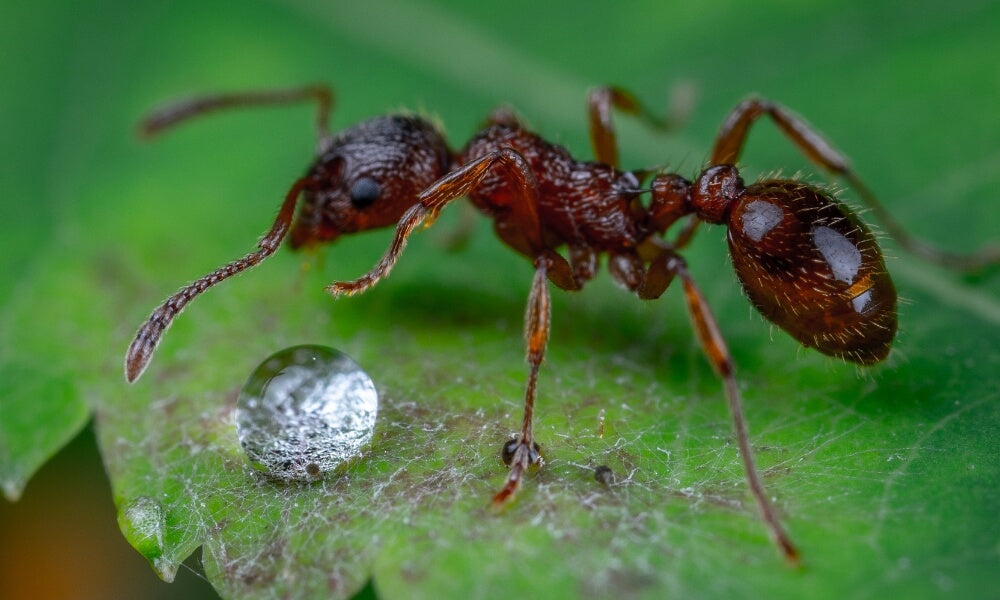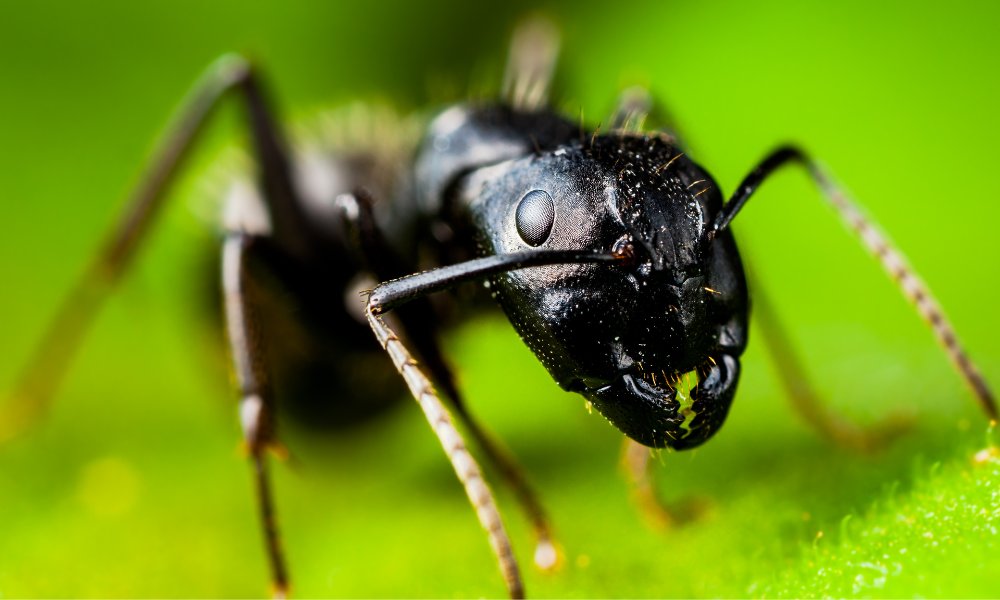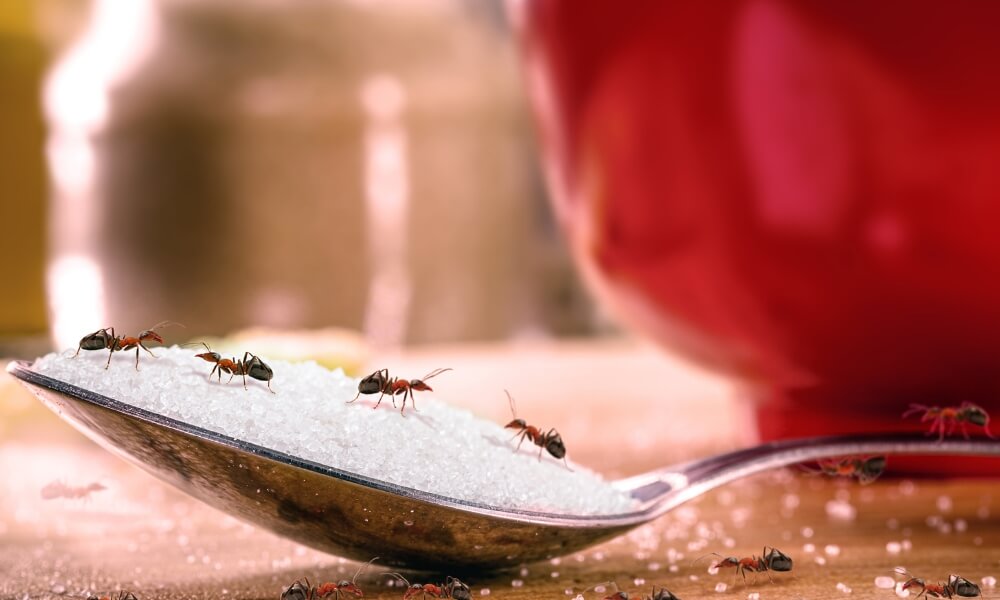Are small red ants taking over your kitchen counters and floors, turning your home into their playground?
We know how frustrating and urgent it feels to deal with an ant invasion. At Dr. Killigan's, we're not just about identifying these tiny invaders; we're here to provide you with effective, non-toxic solutions to reclaim your space.
Let's dive into the world of small red ants together and find out how to send them packing, ensuring your home is truly yours again.
Identifying small red ants in your home
The United States is home to various ant species that can often be mistaken for one another. Identifying the specific type of small red ant invading your space is crucial for choosing the most effective method to eliminate them. Grab your magnifying glass and let's zero in on the common indoor species, emphasizing those red ants that tend to venture inside.

Argentine ants: These ants, with light brown to reddish bodies and a unique, dark heart-shaped abdomen, measure about 0.13 inches. Preferring sugary foods, they often form long, distinctive trails to and from food sources.
Where common: Florida and Texas
Notable feature: Their erratic, "crazy" movement when disturbed
Caribbean crazy ants: Known for their golden reddish-brown hue and slightly smaller size of around 0.13 inches, these ants are distinguished by their erratic movement patterns, often forming visible trails.
Where common: Florida and Texas
Notable feature: Their erratic, "crazy" movement when disturbed
Fire ants: Sporting a deep red color, these ants range from 0.13 to 0.5 inches in size and are notorious for their painful stings.
Where common: Texas, Florida, and throughout the Southern U.S.
Notable feature: Aggressive behavior when their mound is disturbed.
Odorous house ants: These ants are darker and smaller than fire ants and are notable for the distinct rotten coconut smell they emit when crushed.
Where common: Across the U.S.
Notable feature: Emitting a strong odor when crushed, similar to rotten coconuts
Pharaoh ants: Measuring up to 0.063 inches, these tiny reddish-brown ants with a black abdomen are known for their preference for proteins, sugar, and fats.
Where common: Urban areas throughout the U.S.
Notable feature: Their colonies can thrive in a wide range of indoor environments, from hospitals to apartment buildings

Carpenter ants: While not typically red, these ants can range from reddish-black to pure black.
Where common: Wooded areas across the U.S., particularly in the Northeast and Northwest
Notable feature: Their ability to damage wood structures when creating their nests.
Observation tip: Watch how these ants react when disturbed. Their behavior can give you clues to their species. For instance, the frantic movement of Caribbean crazy ants compared to the more deliberate march of Argentine ants can be a giveaway.
Information tip: Ant activity is more pronounced in warmer climates, particularly in the Southern states. Residents in these areas should be extra vigilant in implementing preventive measures to avoid infestations.
What draws ants to your kitchen
Ants invade your home in search of three main things: food, water and shelter. Here's how to make your home less appealing to them:

- Food: Ants aren't picky eaters. Keep your kitchen spotless by promptly cleaning up spills and crumbs, storing food in airtight containers and conducting regular deep cleans. Reduce attractions by keeping fruits in the fridge and cleaning greasy surfaces thoroughly. Tip: Place bay leaves in dry goods as a natural repellent.
- Moisture: All ants need water to survive. Eliminate moisture by fixing leaky pipes, wiping down wet surfaces and ensuring your home is well-ventilated. Regularly inspect pipes and faucets for leaks and keep windows sealed during wet weather.
- Shelter: Some ants hibernate indoors during winter, seeking warmth. Seal cracks in walls or foundations to block their entry. Addressing decaying wood around your home by replacing or removing it can deter carpenter ants. Clearing out tree stumps and storing firewood away from your house also reduces shelter options for ants.
Comprehensive ant control with Dr. Killigan's plant-powered solutions
Battling an ant invasion demands a strategy that's both effective and safe for your home environment. Dr. Killigan's is committed to providing you with solutions that meet these needs, offering Six Feet Under Plant-Powered Insect Spray and Dust to Dust Plant-Powered Insect Powder, products that are designed to eliminate ants without the use of harsh chemicals.
Six Feet Under: Your first line of defense against ants

Six Feet Under is not your average pest control spray. Crafted with a powerful blend of soybean, clove and cinnamon oils, this all-natural, non-toxic spray ensures that ants—and a wide array of insect pests—are stopped in their tracks. Its effectiveness is immediate, killing pests on contact, and it doesn't stop there. Six Feet Under continues to protect your home residually for up to 30 days, making it a formidable barrier against future invasions.
Application is simple and versatile. Spray Six Feet Under directly onto floors, along entry points, and anywhere else ants are known to tread. Its plant-based formula is designed to target the entire bodies of ants, preventing them from developing resistance. This ensures long-term effectiveness and peace of mind.
Dust to Dust: The ultimate ant extermination powder
For those seeking a targeted approach to ant control, Dr. Killigan's Dust to Dust offers an innovative solution. This eco-friendly powder is a fusion of super-fine silica and essential oil nanotechnology, making it deadly to ants upon contact. Dust to Dust works by disrupting the exoskeletons of ants, leading to dehydration and death, all within 24 hours of contact.

Dust to Dust is incredibly versatile and can be used both indoors and outdoors. Apply it around the perimeter of your home as a preventative measure or directly at the source of infestation to fortify your defenses. It is especially effective in cracks, crevices and other hidden areas where ants build their nests.
This potent formula is lab-proven to be highly effective against a broad spectrum of insects — including roaches, fleas, ticks, silverfish, and earwigs — in addition to ants. Its non-toxic nature ensures that your family and pets remain unharmed while delivering a fatal blow to unwanted pests.
Note: As long as it’s present, it’s effective. Reapply as necessary. And when it’s time to vacuum it up, use a vacuum with a HEPA filter.
Embracing a pest-free lifestyle with Dr. Killigan's
Insects can be persistent in their attempts to invade your space, but with Dr. Killigan's, you have the upper hand. By incorporating Six Feet Under and Dust to Dust into your ant control strategy, you can achieve a pest-free home without compromising on safety. These products embody Dr. Killigan's commitment to providing powerful, plant-powered solutions that respect your health and the environment.
Transform your home into a fortress against ants and other pests with Dr. Killigan's non-toxic solutions. For more information and to explore our full range of products, visit Dr. Killigan's website. Together, let's secure your home against unwanted invaders, ensuring a healthy, harmonious living space for you and your loved ones.
Remember, when it comes to ants, knowledge and prevention go hand in hand with effective treatment. Equip yourself with the right tools and knowledge, and those tiny red ants won't stand a chance.





















